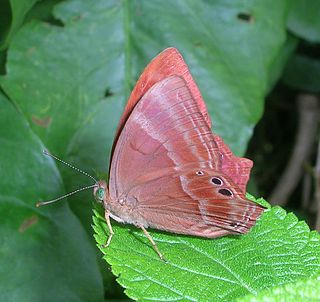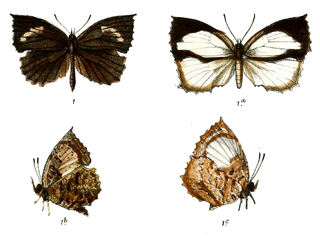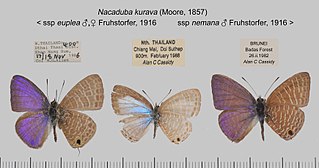
Abisara echerius, the plum Judy, is a small but striking butterfly found in Asia belonging to the Punches and Judies family (Riodinidae). It is difficult to distinguish it from Abisara bifasciata.

Meandrusa sciron, the brown gorgon, is a species of swallowtail found in parts of South Asia and Southeast Asia. It belongs to the hooked swallowtails genus, Meandrusa, of the family Papilionidae. The butterfly is found in India from Sikkim to Assam and north Burma and is not considered to be threatened. Though not uncommon, it is protected under Indian law under the name gyas.

Dodona dipoea, the lesser Punch, is a small but striking butterfly found in the Indomalayan realm that belongs to the Punches and Judies, that is, the family Riodinidae.

Miletus boisduvali, the common brownie, is a small but striking butterfly found in India and Myanmar that belongs to the lycaenids or blues family.

Miletus symethus, the great brownie, is a small butterfly found in India that belongs to the lycaenids or blues family. The species was first described by Pieter Cramer in 1777.

Allotinus multistrigatus, the great darkie, is a small butterfly found in India that belongs to the lycaenids or blues. The species was first described by Lionel de Nicéville in 1886.

Allotinus drumila, the crenulate darkie, is a small butterfly found in India, Burma, Thailand, Laos, Vietnam, and Yunnan (China) that belongs to the lycaenids or blues family.

Tarucus theophrastus, the common tiger blue, pointed Pierrot or African Pierrot, is a small butterfly found in the Old World tropics. It belongs to the lycaenids or blues family.

Azanus jesous, the African babul blue or topaz-spotted blue, is a small butterfly found in Africa, Egypt, Syria, India, Sri Lanka and Myanmar that belongs to the lycaenids or blues family.

Jamides bochus, the dark cerulean, is a small butterfly found in Indomalayan realm that belongs to the lycaenids or blues family. The species was first described by Caspar Stoll in 1782.

Jamides celeno, the common cerulean, is a small butterfly found in Indomalayan realm belonging to the lycaenids or blues family. The species was first described by Pieter Cramer in 1775.

Anthene emolus, the ciliate blue, is a small butterfly found in India and southeast Asia that belongs to the lycaenids or blues family. The species was first described by Jean-Baptiste Godart in 1823.

Petrelaea dana, the dingy lineblue, is a species of lycaenid butterfly found in Indomalayan realm.

Nacaduba kurava, the transparent six-line blue, is a Lycaenidae butterfly found in Asia and Australia. The species was first described by Frederic Moore in 1857.

Prosotas nora, the common lineblue, is a species of lycaenid butterfly found in Asia to Australia. The species was first described by Rudolf Felder in 1860.

Nacaduba hermus, the pale four-line blue, is a species of lycaenid butterfly found in Indomalayan realm. The species was first described by Baron Cajetan von Felder in 1860.

Nacaduba berenice, the rounded six-line blue, is a lycaenid butterfly found in Indomalayan realm. The species was first described by Gottlieb August Wilhelm Herrich-Schäffer in 1869.

Vindula erota, the common cruiser, is a species of nymphalid butterfly found in forested areas of tropical South Asia and Southeast Asia.

Catochrysops strabo, the forget-me-not, is a small butterfly found in Asia that belongs to the lycaenids or blues family. The species was first described by Johan Christian Fabricius in 1793. It is found in Sri Lanka, India, from Sikkim to Indochina and in Sundaland, Sulawesi and the Philippines.

Catopyrops ancyra, or Felder's lineblue, is a species of butterfly belonging to the lycaenid family described by Cajetan Felder in 1860. It is found in the Indomalayan and Australasian realms.





















